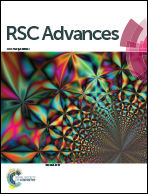Supramolecular self-assembly and physical-gel formation in disc-like liquid crystals: a scalable predictive model for gelation and an application in photovoltaics
Abstract
The application of triphenylene-based discotic liquid crystal derivatives as physical gelators is investigated. In particular, we focus on 2,3,6,7,10,11-hexakis-pentyloxytriphenylene (HAT5) and the longer alkyl chain homologue (HAT6). The driving mechanisms behind and parameter space of non-covalent physical gel formation is studied. A Hansen solubility parameter (HSP) approach is used to predict physical gelation of these disc-like liquid crystalline molecules in a variety of common organic and inorganic solvents important to electrochemical devices. Our results show that HSP analysis is very useful for the prediction of gel formation. The results are transferrable and can form the basis for future investigations into liquid crystalline physical gels. Furthermore, we use acetonitrile as a solvent and apply the gels as electrolytes in dye sensitized solar cells. It is observed that using a binary mixture of gelators results in average photovoltaic power conversion efficiencies as high as 7.21%, compared to a 5.9% reference electrolyte. This is attributed to a reduction in electron recombination at the n-type interface and provides further insight about hybrid gelators. Coupled with an increase in device stability, the results are promising for gel-based dye sensitized solar cells as well as potentially other electrolytic devices such as batteries and supercapacitors.



 Please wait while we load your content...
Please wait while we load your content...